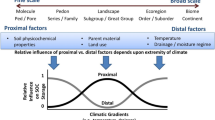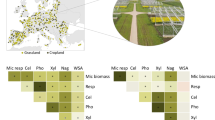Abstract
The spatial distribution of soil carbon (C) is controlled by ecological processes that evolve and interact over a range of spatial scales across the landscape. The relationships between hydrologic and biotic processes and soil C patterns and spatial behavior are still poorly understood. Our objectives were to (i) identify the appropriate spatial scale to observe soil total C (TC) in a subtropical landscape with pronounced hydrologic and biotic variation, and (ii) investigate the spatial behavior and relationships between TC and ecological landscape variables which aggregate various hydrologic and biotic processes. The study was conducted in Florida, USA, characterized by extreme hydrologic (poorly to excessively drained soils), and vegetation/land use gradients ranging from natural uplands and wetlands to intensively managed forest, agricultural, and urban systems. We used semivariogram and landscape indices to compare the spatial dependence structures of TC and 19 ecological landscape variables, identifying similarities and establishing pattern–process relationships. Soil, hydrologic, and biotic ecological variables mirrored the spatial behavior of TC at fine (few kilometers), and coarse (hundreds of kilometers) spatial scales. Specifically, soil available water capacity resembled the spatial dependence structure of TC at escalating scales, supporting a multi-scale soil hydrology-soil C process–pattern relationship in Florida. Our findings suggest two appropriate scales to observe TC, one at a short range (autocorrelation range of 5.6 km), representing local soil-landscape variation, and another at a longer range (119 km), accounting for regional variation. Moreover, our results provide further guidance to measure ecological variables influencing C dynamics.




Similar content being viewed by others
References
Ahn M-Y, Zimmerman AR, Comerford NB, Sickman JO, Grunwald S (2009) Carbon mineralization and labile organic carbon pools in the sandy soils of a North Florida watershed. Ecosystems 12:672–685
Blöschl G (1999) Scale issues in snow hydrology. Hydrol Process 13:2149–2175
Blöschl G, Sivapalan M (1995) Scale issues in hydrological modeling: a review. Hydrol Process 9:251–290
Bruland GL, Grunwald S, Osborne TZ, Reddy KR, Newman S (2006) Spatial distribution of soil properties in Water Conservation Area 3 of the Everglades. Soil Sci Soc Am J 70:1662–1676
Chilès JP, Delfiner P (1999) Geostatistics: modeling spatial uncertainty. Wiley, New York
Corstanje R, Grunwald S, Reddy KR, Osborne TZ, Newman S (2006) Assessment of the spatial distribution of soil properties in a Northern Everglades marsh. J Environ Qual 35:938–949
Florida Fish and Wildlife Conservation Commission (FWC) (2003) Digital vegetation and land cover data set for Florida derived from 2003 Landsat ETM+ imagery. FWC, Tallahassee
Florida Soil Characterization Database (2009) Florida soil characterization data retrieval system. http://flsoils.ifas.ufl.edu. Accessed January 2009
Freeman C, Ostle N, Kang H (2001) An enzymic ‘latch’ on a global carbon store. Nature 409:149
Grunwald S (2006) What do we really know about the space–time continuum of soil-landscapes? In: Grunwald S (ed) Environmental soil-landscape modeling: geographic information technologies and pedometrics. CRC Press, Boca Raton, pp 3–36
Guo LB, Gifford RM (2002) Soil carbon stocks and land use change: a meta analysis. Glob Change Biol 8:345–360
Hancock GR, Murphy D, Evans KG (2010) Hillslope and catchment scale soil organic carbon concentration: an assessment of the role of geomorphology and soil erosion in an undisturbed environment. Geoderma 155:36–45
Hay GJ, Marceau DJ, Dubé P, Bouchard A (2001) A multiscale framework for landscape analysis: object-specific analysis and upscaling. Landscape Ecol 16:471–490
Hengl T, Heuvelink GBM, Stein A (2004) A generic framework for spatial prediction of soil variables based on regression-kriging. Geoderma 120:75–93
Keitt TH, Urban DL, Milne BT (1997) Detecting critical scales in fragmented landscapes. Conserv Ecol 1:4. http://www.consecol.org/vol1/iss1/art4. Accessed January 2010
Liu D, Wang Z, Zhang B, Song K, Li X, Li J, Li F, Duan H (2006) Spatial distribution of soil organic carbon and analysis of related factors in croplands of the black soil region, Northeast China. Agric Ecosyst Environ 113:73–81
McBratney AB (1998) Some considerations on methods for spatially aggregating and disaggregating soil information. Nutr Cycl Agroecosyst 50:51–62
McBratney AB, Pringle MJ (1999) Estimating average and proportional variograms of soil properties and their potential use in precision agriculture. Precis Agric 1:125–152
McGarigal K, Cushman SA, Neel MC, Ene E (2002) FRAGSTATS: spatial pattern analysis program for categorical maps. http://www.umass.edu/landeco/research/fragstats/fragstats.html. Accessed January 2010
McGrath D, Zhang C (2003) Spatial distribution of soil organic carbon concentrations in grassland of Ireland. Appl Geochem 18:1629–1639
Moody A, Woodcock CE (1995) The influence of scale and the spatial characteristics of landscapes on land-cover mapping using remote sensing. Landscape Ecol 10:363–379
Mueller TG, Pierce FJ (2003) Soil carbon maps: enhancing spatial estimates with simple terrain attributes at multiple scales. Soil Sci Soc Am J 67:258–267
Murty D, Kirschbaum MUF, McMurtrie RE, McGilvray H (2002) Does conversion of forest to agricultural land change soil carbon and nitrogen? A review of the literature. Glob Change Biol 8:105–123
National Climatic Data Center (NCDC), National Oceanic and Atmospheric Administration (2008) Monthly surface data. NCDC, Asheville. http://www.ncdc.noaa.gov/oa/ncdc.html. Accessed February 2008
Natural Resources Conservation Service, U.S. Department of Agriculture (USDA) (1996) Soil survey laboratory methods manual. Version 3.0. Soil survey investigations report, vol 42. USDA, Washington, DC
Natural Resources Conservation Service (NRCS), U.S. Department of Agriculture (2006) State Soil Geographic (STATSGO) database. NRCS, Fort Worth
Natural Resources Conservation Service (NRCS), U.S. Department of Agriculture (2009) Soil Survey Geographic (SSURGO) database. NRCS, Fort Worth
Ostle NJ, Levy PE, Evans CD, Smith P (2009) UK land use and soil carbon sequestration. Land Use Policy 26S:S274–S283
Parton WJ, Schimel DS, Cole CV, Ojima DS (1987) Analysis of factors controlling soil organic matter levels in Great Plains grasslands. Soil Sci Soc Am J 51:1173–1179
Pei T, Qin C-Z, Zhu A-X, Yang L, Luo M, Li B, Zhou C (2010) Mapping soil organic matter using the topographic wetness index: a comparative study based on different flow-direction algorithms and kriging methods. Ecol Indic 10:610–619
Phachomphon K, Dlamini P, Chaplot V (2010) Estimating carbon stocks at a regional level using soil information and easily accessible auxiliary variables. Geoderma 155:372–380
Post WM, Kwon KC (2000) Soil carbon sequestration and land-use change: processes and potential. Glob Change Biol 6:317–327
Reddy KR, Patrick WH Jr (1975) Effect of alternate aerobic and anaerobic conditions on redox potential, organic matter decomposition and nitrogen loss in a flooded soil. Soil Biol Biochem 7:87–94
Rivero RG, Grunwald S, Osborne TZ, Reddy KR, Newman S (2007) Characterization of the spatial distribution of soil properties in Water Conservation Area 2A, Everglades, Florida. Soil Sci 172:149–166
Simbahan GC, Dobermann A, Goovaerts P, Ping J, Haddix ML (2006) Fine-resolution mapping of soil organic carbon based on multivariate secondary data. Geoderma 132:471–489
Terra JA, Shaw JN, Reeves DW, Raper RL, van Santen E, Mask PL (2004) Soil carbon relationships with terrain attributes, electrical conductivity, and soil survey in a coastal plain landscape. Soil Sci 169:819–831
United States Geological Survey (USGS) (1984) Digital elevation model (DEM) of Florida. USGS, Reston
United States Geological Survey (USGS) (1999) National Elevation Dataset (NED). USGS, Sioux Falls
van Meirvenne M, Pannier J, Hofman G, Louwagie G (1996) Regional characterization of the long-term change in soil organic carbon under intensive agriculture. Soil Use Manag 12:86–94
Vasques GM, Grunwald S, Comerford NB, Sickman JO (2010a) Regional modelling of soil carbon at multiple depths within a subtropical watershed. Geoderma 156:326–336
Vasques GM, Grunwald S, Comerford NB, Sickman JO (2010b) Upscaling of dynamic soil organic carbon pools in a north-central Florida watershed. Soil Sci Soc Am J 74:870–879
Walkley A, Black IA (1934) An examination of the Degtjareff method for determining soil organic matter and a proposed modification of the chromic acid titration method. Soil Sci 37:29–38
Wang H, Hall CAS, Cornell JD, Hall MHP (2002) Spatial dependence and the relationship of soil organic carbon and soil moisture in the Luquillo Experimental Forest, Puerto Rico. Landscape Ecol 17:671–684
Zhang C, McGrath D (2004) Geostatistical and GIS analyses on soil organic carbon concentrations in grassland of southeastern Ireland from two different periods. Geoderma 119:261–275
Zhou T, Shi P, Luo J, Shao Z (2008) Estimation of soil organic carbon based on remote sensing and process model. Front For China 3:139–147
Acknowledgments
We thank Nicholas B. Comerford, Christine M. Bliss, Gregory L. Bruland, Wade Hurt, Willie G. Harris, Chunhao Xu, Deoyani Sarkhot, and Sanjay Lamsal for their support in soil sampling, analysis, and data preparation. We also thank the Soil and Water Science Department at the University of Florida, the Natural Resources Conservation Service, and the Florida Department of Transportation for funding and support to produce the Florida Soil Characterization database. Funding for this research was provided from various projects including “Linking Experimental and Soil Spectral Sensing for Prediction of Soil Carbon Pools and Carbon Sequestration at Landscape Scales” (Cooperative Ecosystem Studies Unit, Natural Resources Conservation Service, U.S. Department of Agriculture), and “Rapid Assessment and Trajectory Modeling of Changes in Soil Carbon across a Southeastern Landscape” (core project of the North American Carbon Program) (Agriculture and Food Research Initiative, National Institute of Food and Agriculture, U.S. Department of Agriculture), and from the University of Florida Alumni Fellowship program.
Author information
Authors and Affiliations
Corresponding author
Additional information
G. M. Vasques and D. B. Myers were formerly at Soil and Water Science Department, University of Florida.
Rights and permissions
About this article
Cite this article
Vasques, G.M., Grunwald, S. & Myers, D.B. Associations between soil carbon and ecological landscape variables at escalating spatial scales in Florida, USA. Landscape Ecol 27, 355–367 (2012). https://doi.org/10.1007/s10980-011-9702-3
Received:
Accepted:
Published:
Issue Date:
DOI: https://doi.org/10.1007/s10980-011-9702-3




